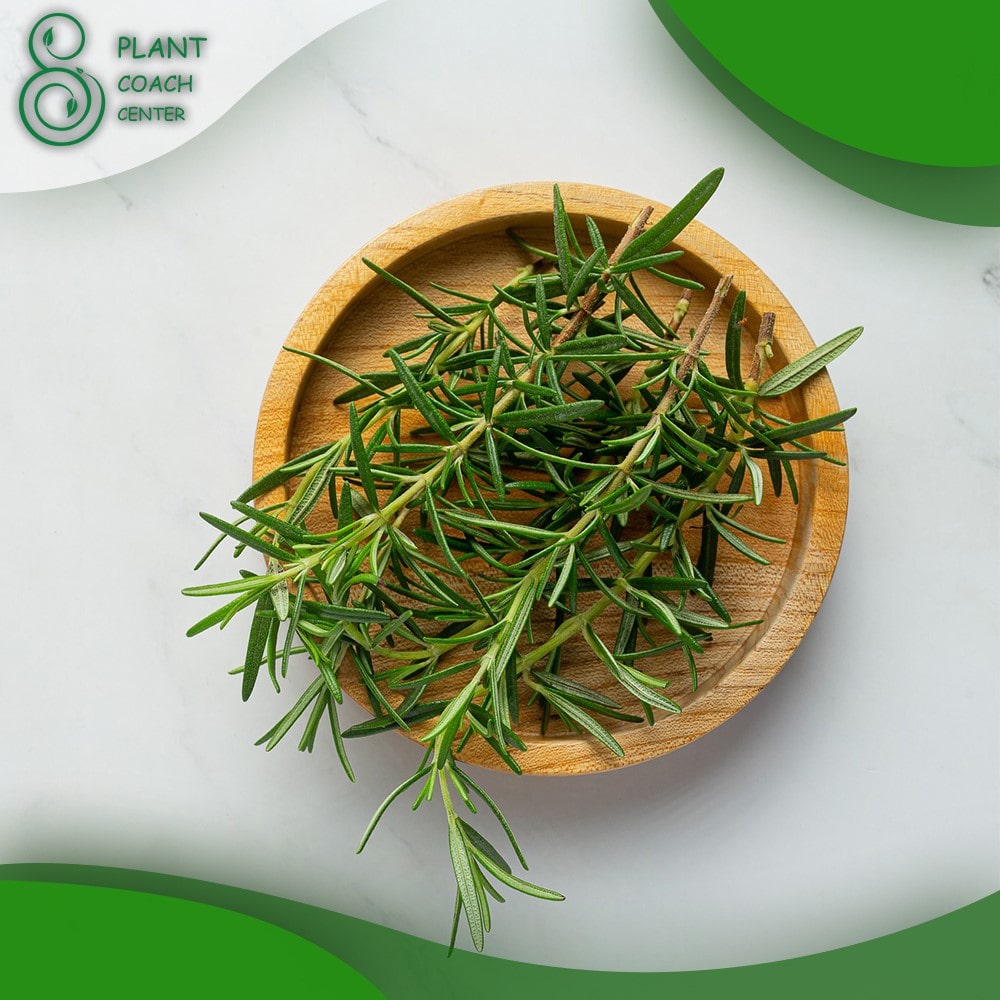When to Cut Back Rosemary
Rosemary is a beloved herb known for its aromatic leaves and versatile culinary uses. As a gardener or herb enthusiast, it’s crucial to understand the importance of pruning and maintaining rosemary plants to ensure their health and productivity. This article will delve into rosemary pruning, exploring when and how to cut back this perennial herb for optimal growth and vitality.
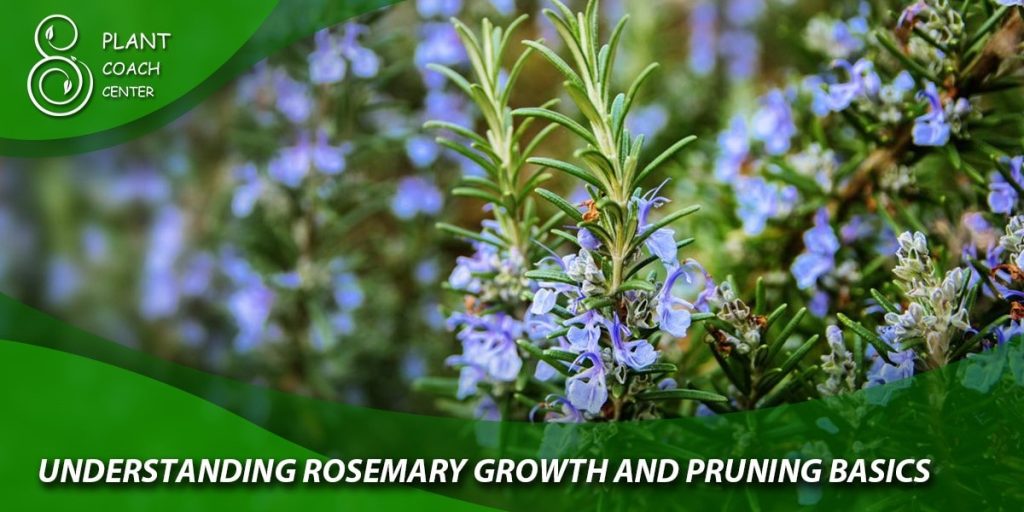
Understanding Rosemary Growth and Pruning Basics
Rosemary is a woody, evergreen shrub that can grow into a bushy, sprawling plant if left unattended. Regular pruning keeps the plant’s size in check and encourages fresh growth, enhances the overall appearance, and improves air circulation around the foliage. Before we delve into the specifics of pruning, let’s explore rosemary’s growth habits and characteristics.
Rosemary plants typically grow upright, reaching heights up to 3-5 feet. The leaves are narrow, needle-like, and emit a distinct fragrance when crushed. Pruning is pivotal in maintaining the plant’s shape and preventing it from becoming overly leggy or straggly. Removing old or damaged growth can promote vigorous new shoots and keep the plant compact.
Pruning rosemary is best approached with the right tools and techniques. Sharp pruning shears or secateurs are essential for making clean cuts without causing damage to the plant. Additionally, understanding different pruning methods, such as pinching and shearing, allows you to tailor your approach to the specific needs of your rosemary plant.
Signs It’s Time to Prune Rosemary
Overgrowth and Leggy Growth Patterns
When you notice your rosemary plant becoming unruly, sprawling, or excessively tall, it indicates that pruning is necessary. Over time, rosemary plants can grow vigorously and lose their compact shape. Pruning helps control their size and encourages bushier growth, making the plant more visually appealing and easier to manage.
Stress or Decline in the Plant
Suppose you observe signs of stress or decline in your rosemary plants, such as wilting, yellowing leaves, or sparse foliage. In that case, pruning can help revitalize the plant. Start by inspecting the plant for any dead, diseased, or damaged branches and remove them. Pruning stimulates new growth and redirects the plant’s resources towards healthier areas, promoting overall plant vitality.
Growth Stage of the Plant
The growth stage of your rosemary plant can also influence the timing of pruning. Young rosemary plants benefit from regular pruning to encourage branching and density. Removing the tender tips of new growth can promote lateral shoots and achieve a fuller, more robust plant.
On the other hand, more established rosemary plants may require pruning to invigorate growth or address specific issues. Over time, the center of the plant can become woody and less productive. Pruning out the older, less productive branches encourages fresh growth from the base of the plant and improves overall plant health.
By paying attention to these signs, you can determine the right time to prune your rosemary plant. Regular pruning helps maintain the plant’s shape, encourages healthy growth, and prevents the plant from becoming overly leggy or straggly. It also allows for removing diseased or damaged branches, promoting the overall vigour and longevity of the plant.
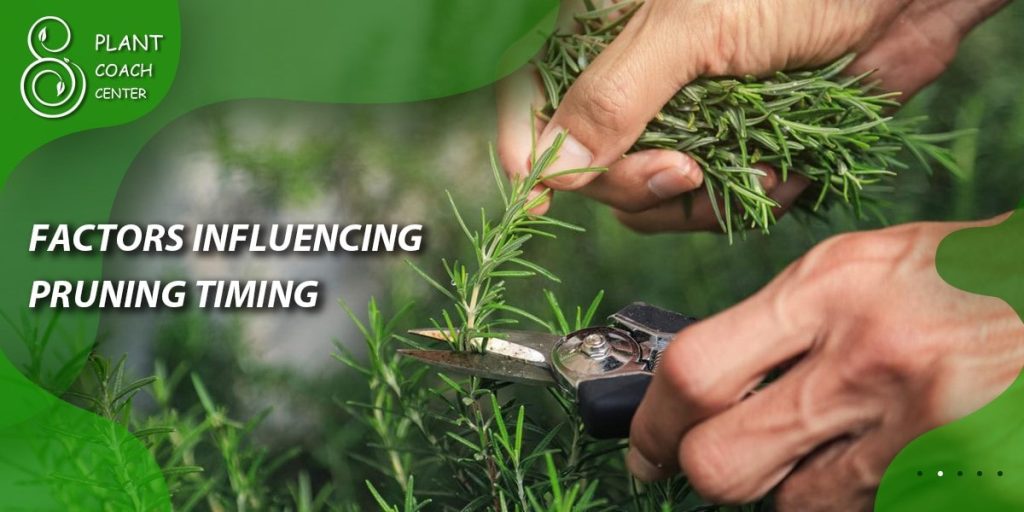
Factors Influencing Pruning Timing
Pruning timing can vary depending on several factors, including climate, seasonal variations, and the location of your rosemary plant. Understanding these factors will help determine the most appropriate time to cut back on your rosemary.
Climate plays a significant role in determining the pruning schedule for rosemary. Pruning can be done throughout the year in regions with mild winters, such as Mediterranean climates. However, in colder climates, limiting pruning to the spring and summer months is advisable when the plant is actively growing and less susceptible to frost damage.
Considering seasonal variations is another important aspect of timing your pruning efforts. Spring pruning allows for the removal of winter damage and prepares the plant for the upcoming growing season. On the other hand, summer pruning can help control growth and maintain the plant’s shape. Fall and winter pruning, if applicable to your region, are often done to reduce the risk of winter damage and maintain the plant’s health during dormancy.
Finding the right balance between pruning and allowing the plant to grow naturally. Pruning too frequently or excessively can stress the plant and impede its growth, while neglecting to prune can result in an unruly and less productive rosemary plant. Understanding your rosemary’s specific needs and growth patterns will guide you in determining the best pruning timing.
Best Time to Cut Back Rosemary
Now that we have a solid understanding of rosemary growth, pruning basics, and factors influencing pruning timing, let’s delve into the specific recommendations for when to cut back rosemary throughout the year.
Spring Pruning
Spring is an ideal time to prune rosemary, especially in regions with mild winters. As the weather starts to warm up and the plant emerges from its dormant period, spring pruning helps revitalize the plant and prepare it for the upcoming growing season. It’s recommended to wait until any risk of frost has passed before pruning.
Inspect the rosemary plant for dead or damaged branches during spring pruning. Remove these branches by making clean cuts close to the main stem, just above a leaf node or lateral branch. This deadwood removal allows the plant to focus its energy on healthy growth and prevents potential disease issues.
Spring pruning also helps shape the rosemary plant and maintain a compact form. By selectively removing long or leggy branches, you can encourage the development of a bushier and more visually appealing plant. Additionally, spring pruning promotes air circulation within the plant, reducing the risk of fungal diseases.
Summer Pruning
While spring is the primary pruning season for rosemary, light pruning during the summer can also be beneficial. During this time, rosemary plants are in their peak growth phase, producing new shoots and foliage. Summer pruning is particularly useful for controlling excessive growth and maintaining the desired shape of the plant.
When performing summer pruning, focus on removing leggy branches or parts of the plant obstructing sunlight and air circulation. Avoid extensive pruning during this time, as it can disrupt flower production, as rosemary typically blooms during the summer. Instead, aim for minor trimming and shaping to keep the plant tidy and encourage bushier growth.
Fall and Winter Pruning
In regions with milder climates, fall and winter pruning can be done to maintain the health and appearance of the rosemary plant. Fall pruning is typically done in late autumn before the onset of winter. In contrast, winter pruning can be performed during the dormant period when the plant is not actively growing.
Fall and winter pruning focus on tidying up the plant, removing dead or diseased branches, and shaping the overall form. However, it’s important to exercise caution with pruning during these seasons. Heavy pruning in late fall or winter can stimulate new growth susceptible to frost damage. Therefore, it’s advisable to limit pruning to minimal maintenance cuts and refrain from extensive pruning during these periods.
You can effectively manage your rosemary plant throughout the year by considering the specific timing for each pruning season. Remember to adjust the pruning schedule based on your climate and regional conditions, as well as your individual rosemary plant’s growth patterns and health.
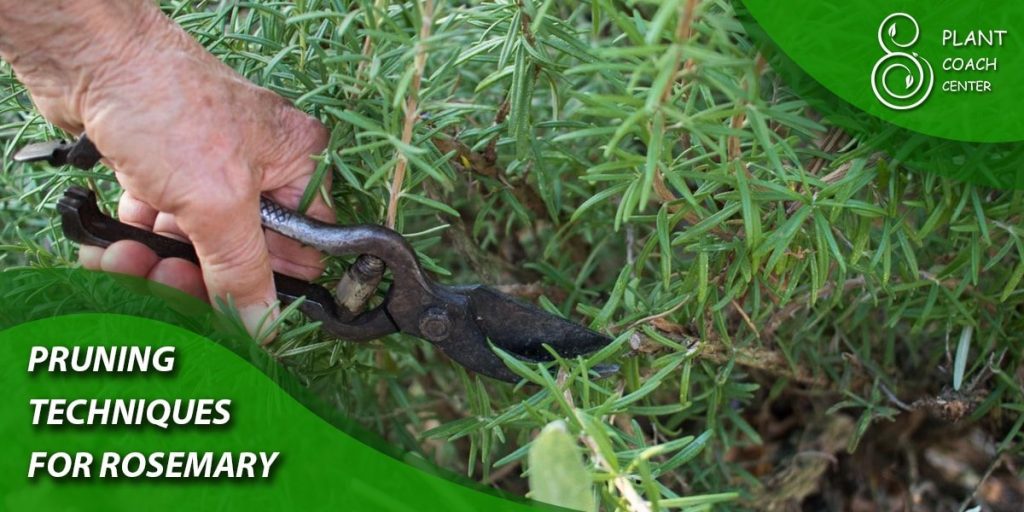
Pruning Techniques for Rosemary
To achieve the best results when pruning rosemary, it’s crucial to employ the right techniques. Let’s explore the main pruning methods and how to execute them effectively:
Pinching
Pinching is a technique that involves removing the tender tips of new growth using your fingers or pruning shears. This method is particularly effective for encouraging branching and promoting a denser, bushier form in rosemary plants.
To pinch rosemary, locate the soft, leafy tips of new growth and gently pinch them off between your thumb and forefinger. Alternatively, you can use pruning shears to make clean cuts just above a leaf node or lateral branch. Aim to remove about an inch of the soft growth, ensuring not to remove too much foliage at once.
Pinching can occur throughout the growing season when you notice excessive elongation or want to maintain a compact, well-shaped rosemary plant. This technique helps stimulate lateral growth, resulting in a fuller and more attractive plant.
Shearing
Shearing is another pruning technique commonly used to shape rosemary plants’ overall form. It involves using pruning shears or hedge trimmers to create a uniform and well-maintained appearance.
When shearing rosemary, it’s important to have a clear idea of the desired shape and size you want to achieve. Start by removing any stray or overgrown branches that disrupt the overall form. Trim the outer layer of foliage to create a neat appearance.
While shearing can be useful for creating formal hedges or geometric shapes with rosemary, it’s important to exercise caution. Avoid cutting into the plant’s woody stems, as they may not regenerate new growth. Focus on shaping the outer layer of foliage while preserving the plant’s internal structure.
When executing pruning cuts, ensure your tools are sharp and clean to make precise and smooth cuts. This helps minimize the risk of damage and promotes quick plant healing.
By employing these pruning techniques, you can effectively shape and maintain the growth of your rosemary plant. Pinching encourages branching and density while shearing helps achieve a well-groomed appearance. Remember to consider your rosemary plant’s specific needs and growth patterns and adjust your pruning techniques accordingly.
Potential Risks and Precautions
While pruning is essential for maintaining the health and appearance of your rosemary plant, it’s important to be aware of potential risks and take appropriate precautions:
Avoid Excessive Pruning
Over-pruning can stress the plant and hinder its ability to grow and recover. Always aim for a balanced approach, removing only what is necessary to maintain the plant’s shape and promote healthy growth.
Beware of Frost Damage
Avoid heavy pruning in late fall or winter in colder regions, as it can stimulate new growth that may be susceptible to frost damage. Pruning too close to the onset of winter can also remove protective foliage, making the plant more vulnerable to freezing temperatures.
Disease Prevention
To minimize the risk of disease transmission, ensure your pruning tools are clean and sharp. Disinfect them between cuts using rubbing alcohol or a diluted bleach solution.
Maintaining Healthy Rosemary Plants
Pruning is just one aspect of overall rosemary plant care. To ensure your rosemary thrives and remains healthy, consider the following maintenance practices:
- Watering:
Rosemary prefers well-draining soil, so water deeply but infrequently, allowing the top few inches of soil to dry out between watering sessions. Avoid overwatering, as rosemary is susceptible to root rot.
- Fertilizing:
Incorporate a balanced, slow-release fertilizer into the soil during the spring to provide essential nutrients. Avoid excessive fertilization, as it can lead to excessive foliage growth at the expense of flavour and aroma.
- Soil Requirements:
Rosemary thrives in slightly alkaline soil with a pH between 6.0 and 7.5. If your soil is acidic, consider adding lime to raise the pH. Additionally, ensure the soil is well-draining to prevent waterlogged conditions.
- Sunlight and Temperature:
Rosemary plants thrive in full sun, requiring at least six hours of direct sunlight daily. They also prefer warm temperatures and are sensitive to frost. If grown in colder regions, consider providing winter protection or growing rosemary in containers that can be moved indoors during extreme cold spells.
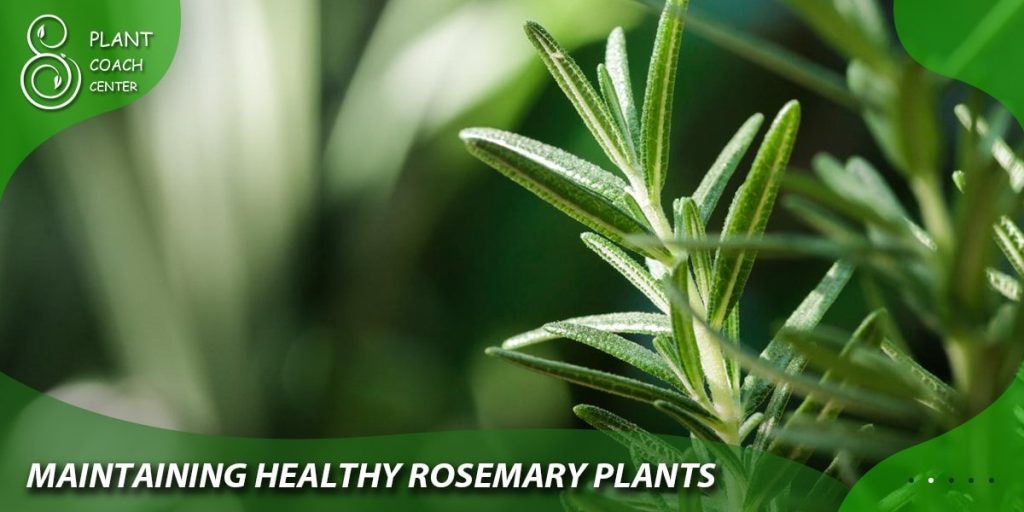
Last words
Pruning rosemary is a vital aspect of plant care. It promotes healthy growth, maintains the plant’s shape, and enhances its appearance. By understanding the signs that indicate pruning is necessary, considering factors that influence pruning timing, and employing proper pruning techniques, you can ensure your rosemary plants’ long-term health and productivity. Remember to balance pruning and allowing the plant to grow naturally, and always practice good maintenance habits to keep your rosemary thriving. Enjoy the benefits of a well-pruned rosemary plant in your garden and savour its aromatic delights in your culinary adventures.
When is the best time to prune rosemary?
Spring is the optimal time for pruning rosemary.
How often should I prune my rosemary plant?
Prune your rosemary plant to maintain its shape and promote healthy growth.
Can I prune rosemary in the winter?
Minimal pruning is recommended during winter to avoid stimulating new growth susceptible to frost damage.


